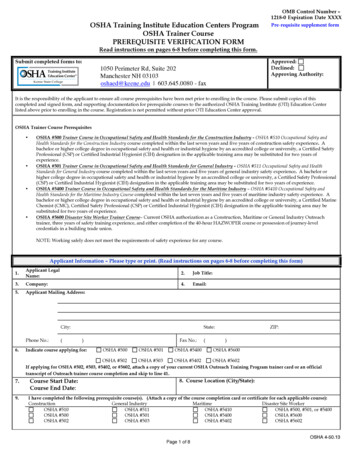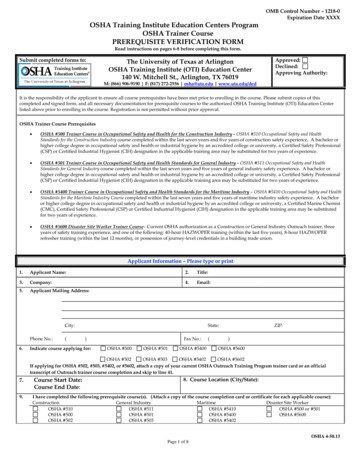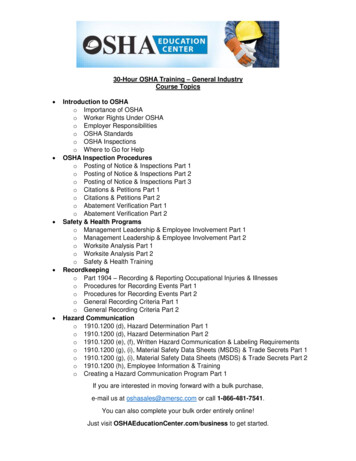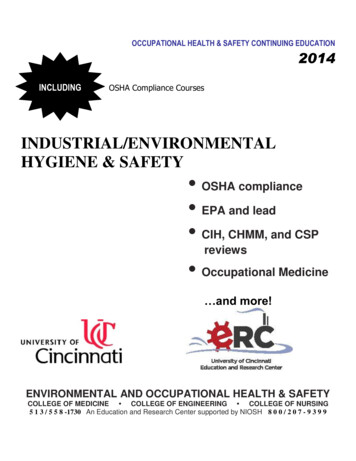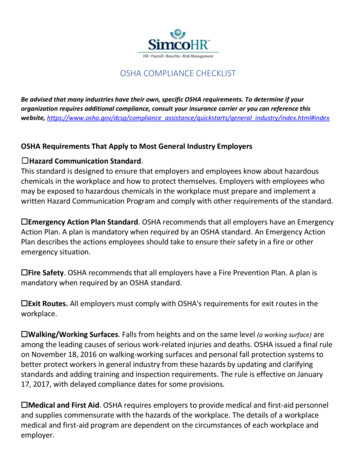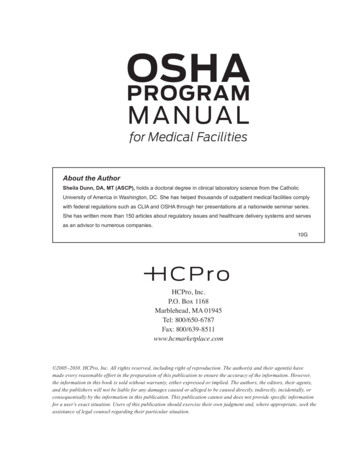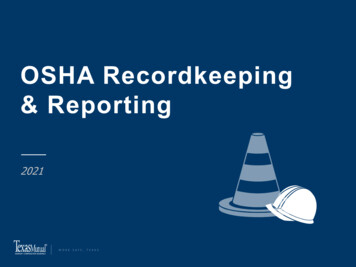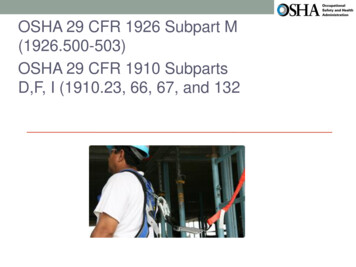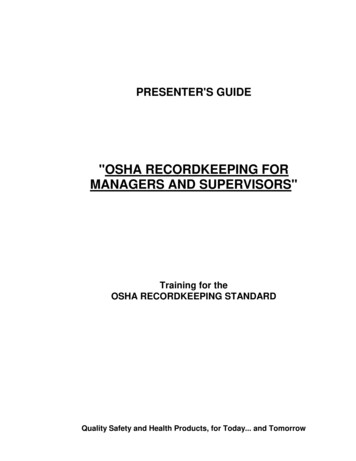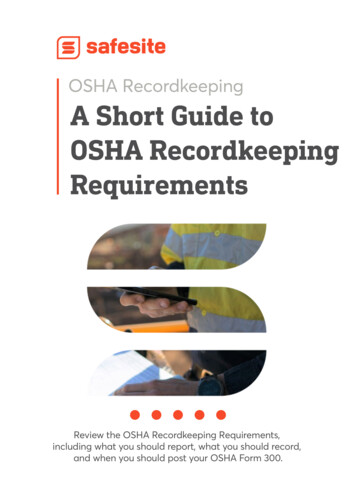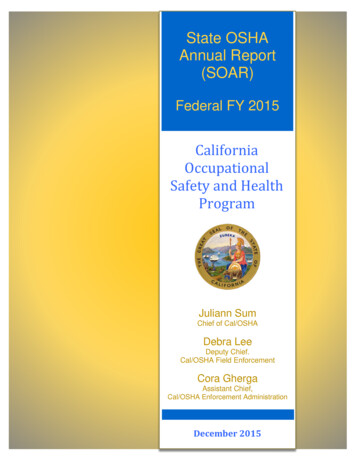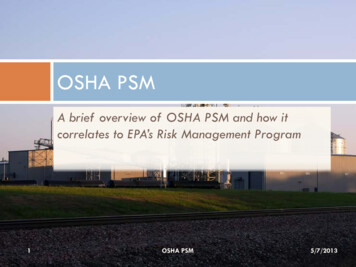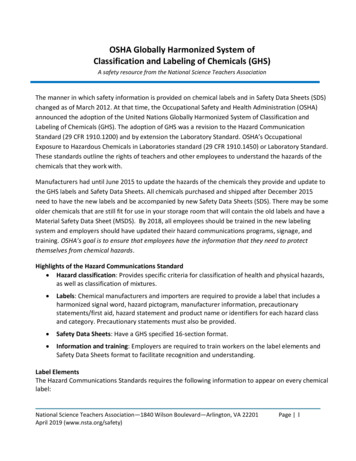
Transcription
OSHA Globally Harmonized System ofClassification and Labeling of Chemicals (GHS)A safety resource from the National Science Teachers AssociationThe manner in which safety information is provided on chemical labels and in Safety Data Sheets (SDS)changed as of March 2012. At that time, the Occupational Safety and Health Administration (OSHA)announced the adoption of the United Nations Globally Harmonized System of Classification andLabeling of Chemicals (GHS). The adoption of GHS was a revision to the Hazard CommunicationStandard (29 CFR 1910.1200) and by extension the Laboratory Standard. OSHA’s OccupationalExposure to Hazardous Chemicals in Laboratories standard (29 CFR 1910.1450) or Laboratory Standard.These standards outline the rights of teachers and other employees to understand the hazards of thechemicals that they work with.Manufacturers had until June 2015 to update the hazards of the chemicals they provide and update tothe GHS labels and Safety Data Sheets. All chemicals purchased and shipped after December 2015need to have the new labels and be accompanied by new Safety Data Sheets (SDS). There may be someolder chemicals that are still fit for use in your storage room that will contain the old labels and have aMaterial Safety Data Sheet (MSDS). By 2018, all employees should be trained in the new labelingsystem and employers should have updated their hazard communications programs, signage, andtraining. OSHA’s goal is to ensure that employees have the information that they need to protectthemselves from chemical hazards.Highlights of the Hazard Communications Standard Hazard classification: Provides specific criteria for classification of health and physical hazards,as well as classification of mixtures. Labels: Chemical manufacturers and importers are required to provide a label that includes aharmonized signal word, hazard pictogram, manufacturer information, precautionarystatements/first aid, hazard statement and product name or identifiers for each hazard classand category. Precautionary statements must also be provided. Safety Data Sheets: Have a GHS specified 16-section format. Information and training: Employers are required to train workers on the label elements andSafety Data Sheets format to facilitate recognition and understanding.Label ElementsThe Hazard Communications Standards requires the following information to appear on every chemicallabel:National Science Teachers Association—1840 Wilson Boulevard—Arlington, VA 22201April 2019 (www.nsta.org/safety)Page 1
The supplier identifier including name, address and telephone number of the chemicalmanufacturer, importer or other responsible party.The product identifier is how the hazardous chemical is identified. This can include the chemicalname, code number, or batch number. This same information must be on both the label andthe safety data sheet.Symbols (GHS hazard pictograms) convey health, physical, and environmental hazardinformation assigned to a GHS hazard class and category. Pictograms include the harmonizedhazard symbols plus other graphic elements, such as borders, background patterns, andsubstances that have target organ toxicity.Signal Words–these are words that are used to describe the severity of the hazard. Only twowords are used as signal words, “Danger” and “Warning”. “Danger” is used for more severehazards.Hazard Statements–these statements include the nature of the hazard(s) of a chemical and thedegree of the hazard.Precautionary Statements–these statements describe measures that are recommended tominimize or prevent adverse effects resulting from exposure to the hazardous chemical orimproper storage and handling. There are four types of precautionary statements: prevention,response, storage, and disposal.Supplementary Information–the manufacturer may provide additional information that itdeems helpful.Employer Responsibilities–employers are responsible for maintaining labels on containers.Workplace Labels–employers continue to have the option to create their own chemical labels,these labels must have all of the information that is on the manufacturer’s label.GHS Label Sample:National Science Teachers Association—1840 Wilson Boulevard—Arlington, VA 22201April 2019 (www.nsta.org/safety)Page 2
Pictograms – these are symbols used to communicate information about the hazards of a product.National Science Teachers Association—1840 Wilson Boulevard—Arlington, VA 22201April 2019 (www.nsta.org/safety)Page 3
Safety Data SheetsThe Hazard Communication Standard requires that chemical manufacturers and distributors provideSafety Data Sheets (SDSs) for each hazardous chemical that they sell. The information in the SDS isgenerally the same as the information previously found in Material Safety Data Sheets (MSDS) but ispresented in a consistent 16 section format that is designed to be user-friendly. Below is a descriptionof each of the 16 sections.Section 1—IdentificationThis information includes the product identifier and common names or synonyms; the name, address,and phone number of the manufacturer and an emergency phone number; and recommended uses ofthe chemical including any restrictions on use.Section 2—Hazard(s) IdentificationThis section identifies the hazards of the chemical and warning information. The required informationin this section includes: Hazard classification Signal word Hazard statement(s) Pictograms Precautionary statement(s) Description of hazards not otherwise classified For a mixture, the percentage of the mixture of unknown toxicitySection 3—Composition/Information on IngredientsThis section includes all ingredients contained in a product including impurities and stabilizingadditives. Included in this section is information on substances, mixtures, and all chemicals where atrade secret is claimed.Required information:Substances Chemical name Common name and synonyms Chemical Abstract Services (CAS) number and other unique identifiers Impurities and stabilizing agentsMixtures Same information as required for substances Chemical name and concentration of all ingredient that are classified as health hazards and:o are present above their cut-off/concentration limits, oro present a health risk below the cut-off/concentration limits.National Science Teachers Association—1840 Wilson Boulevard—Arlington, VA 22201April 2019 (www.nsta.org/safety)Page 4
The concentration of each ingredient must be specified except concentration ranges may beused in the following situations:o a trade secret claim is made,o there is batch-to-batch variation oro the SDS is used for a group of substantially similar mixtures.Chemical where a trade secret is claimed A statement that the specific chemical identity and/or exact percentage (concentration) ofcomposition has been withheld as a trade secret is required.Section 4—First-Aid MeasuresThis section discusses the initial care that should be provided by untrained responders to an individualwho has been exposed to a chemical. The required information includes: First-aid instruction based upon routes of exposure. Description of the most important symptoms or effects, including any symptoms that are acuteor delayed. Recommendations for immediate medical care and special treatment when needed.Section 5—Fire-Fighting MeasuresThis section contains information for fighting a fire caused by a chemical. The recommendationsconsist of: Recommendations of suitable extinguishing equipment. Information on specific hazards that develop from the chemical during a fire, such ascombustion products that develop as the chemical burns. Information on protective equipment or precautions for firefighters.Section 6—Accidental Release MeasuresThis section provides recommendations for the appropriate response to spills, leaks, or releases,including containment and clean-up practices to prevent or minimize exposure to people, property, orthe environment. The recommendations distinguish between large and small spills, where spill volumehas a significant impact on the hazard. The required information includes: Use of personal precautions and protective equipment to prevent contamination. Emergency procedures. Methods and materials used for containment. Clean-up procedures and/or equipment required for clean-up.Section 7—Handling and Storage – This section provides information on the safe handling and storageof chemicals. The required information includes: Precautions for safe handling, including recommendations for handling incompatible chemicals. Recommendations on the safe storage of chemicals including advice on safe storagerequirements.National Science Teachers Association—1840 Wilson Boulevard—Arlington, VA 22201April 2019 (www.nsta.org/safety)Page 5
Section 8—Exposure Controls/Personal ProtectionThis section outlines the engineering controls, personal protective equipment, and exposure limitsneeded to ensure that worker exposure to hazardous chemicals is minimized. The required informationincludes: OSHA Permissible Exposure Limits (PELs) and Threshold Limit Values (TLVs). Appropriate engineering controls. Recommendations for personal protective measures (PPE). Special requirements for PPE, such as respirators, when necessary.Section 9—Physical and Chemical PropertiesThis section identifies the physical and chemical properties of a substance or mixture. The minimumrequired information consists of:Appearance (physical state, color, etc.)Upper/lower flammability or explosive limitsOdorVapor pressureOdor thresholdVapor densitypHRelative densityMelting point/freezing pointSolubility(ies)Initial boiling point and boiling rangePartition coefficient: n-octanol/waterFlash pointAuto-ignition temperatureEvaporation rateDecomposition temperatureFlammability (solid, gas)ViscosityEach SDS may not contain all of the above information; however, a notation must exist to indicate this.Manufacturers may add other relevant information.Section 10—Stability and ReactivityThis section outlines the reactivity of a chemical and the chemical stability. The required informationconsists of:Reactivity Description of specific test data for the chemical.Chemical Stability Indication of whether the chemical is stable under normal temperature conditions, duringstorage and when handled. Description of stabilizers needed to maintain stability. Indication of safety issues that may arise if the physical appearance of the product changes.National Science Teachers Association—1840 Wilson Boulevard—Arlington, VA 22201April 2019 (www.nsta.org/safety)Page 6
Other Indication of possibly hazardous reactions, and a description of the conditions under whichthose reactions occur. List of all conditions to be avoided. List of all classes of incompatible materials with which the product could react. List of any known or anticipated decomposition products that could be produced due to use,storage, or heating.Section 11—Toxicological InformationThis section indicates health information and also indicates if this information is unavailable. Therequired information consists of: Information on the likely routes of exposure. Description of immediate, delayed or chronic effects from short and long-term exposure. The numerical data on toxicity. Description of symptoms. Statement as to whether or not the chemical is listed on the National Toxicology Program (NTP)Report on Carcinogens or has been found to be a potential carcinogen.Section 12—Ecological Information (non-mandatory)This section allows the environmental impact of releasing a chemical into the environment to beevaluated. The information may include: Data from toxicity tests performed on aquatic and/or terrestrial organisms where available. Whether or not there is a tendency for a chemical to persist and degrade in the environment. Results of tests of bioaccumulation potential. The potential for a substance to move from the soil to the groundwater. Other adverse effects.Section 13—Disposal Considerations (non-mandatory)This section provides information on proper disposal practices, recycling or reclamation of chemicalsand their containers, and safe handling practices. The information may include: Description of appropriate disposal containers to use. Recommendations for proper disposal methods to use. Descriptions of physical and chemical properties that may affect disposal methods. Language discouraging sewage disposal. Special precautions for landfills or incinerators.Section 14—Transport Information (non-mandatory)This section provides classification information on shipping and transporting hazardous chemicals. Theinformation pertains to manufacturers and distributors who are shipping their products to users.National Science Teachers Association—1840 Wilson Boulevard—Arlington, VA 22201April 2019 (www.nsta.org/safety)Page 7
Section 15—Regulatory Information (non-mandatory)This section indicates health and safety information and environmental regulations that are not foundelsewhere on the SDS. This would include national or regional regulatory information.Section 16—Other InformationThis section indicates where the SDS was prepared and the date of the latest revision. Any other usefulinformation may also be included in this section.Employers are responsible for making sure that SDSs are readily available and accessible to allemployees. Schools should give a copy of SDSs to the school nurse of each building where chemicalsare used and stored, including chemicals used in cleaning the building. Schools should also provide thisinformation to first responders.Resources:OSHA Brief, Hazard Communication Standard: Labels and 636.pdfOSHA Brief, Hazard Communication Standard: Safety Data pdfNSTA would like to thank its Science Safety Advisory Board for developing this resource. Questionsor comments about its content should be directed to NSTA at 703-243-7100 or safety@nsta.org.Permission is granted in advance for reproduction for purpose of classroom or workshopinstruction. To request permission for other uses, please contact NSTA at safety@nsta.org.NSTA is committed to providing quality material that promotes the best in inquiry-based scienceeducation. However, conditions of actual use may vary, and the safety procedures and practicesdescribed in this resource are intended to serve only as a guide. Additional precautionarymeasures may be required. NSTA and the authors do not warrant or represent that theprocedures and practices in this resources meet any safety code or standard of federal, state, orlocal regulations. NSTA and the authors disclaim any liability for personal inquiry or demand toproperty arising out of or relating to the use of this resource, to include any of therecommendations, instructions, or materials contained therein.National Science Teachers Association—1840 Wilson Boulevard—Arlington, VA 22201April 2019 (www.nsta.org/safety)Page 8
Labeling of Chemicals (GHS). The adoption of GHS was a revision to the Hazard Communication Standard (29 CFR 1910.1200) and by extension the Laboratory Standard. . Recommendations for immediate medical care and special treatment when needed. . Schools should give a copy of SDSs to the school nurse of each building where chemicals : .
